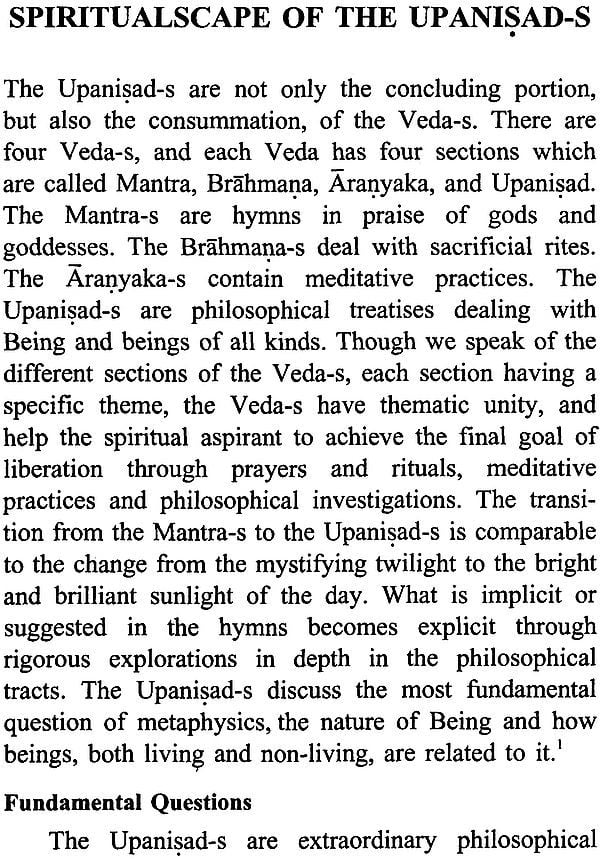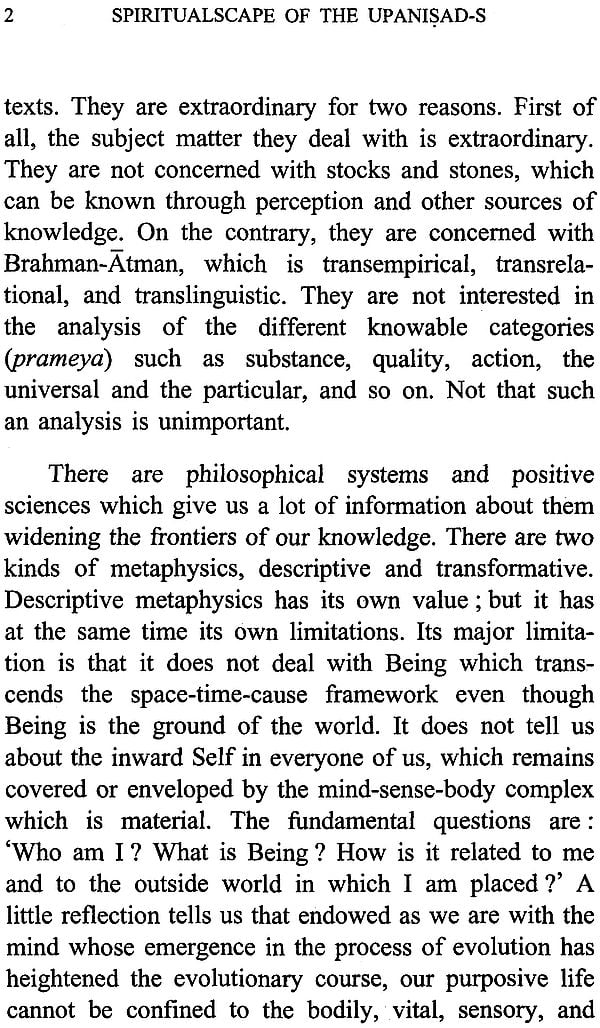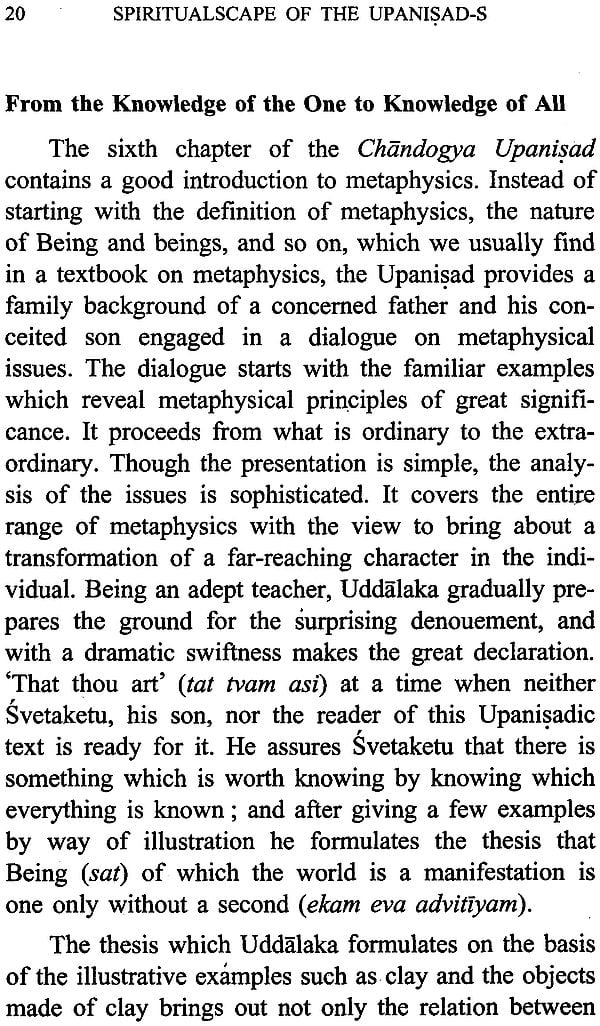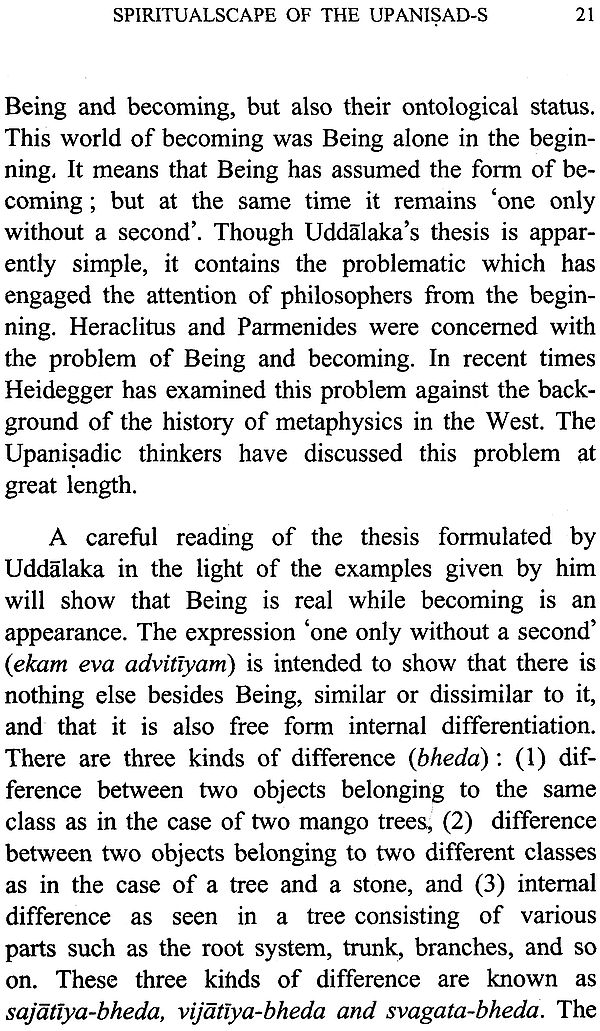
The Spiritualscape of the Upanisad-s
Book Specification
| Item Code: | IHL423 |
| Author: | R. Balasubramanian |
| Publisher: | The Adyar Library and Research Centre |
| Edition: | 2007 |
| ISBN: | 8185141568 |
| Pages: | 28 |
| Cover: | Paperback |
| a54_books | |
| Other Details | 8.5 inch X 5.6 inch |
Book Description
Preface
All the schools of Indian philosophy, barring the Carvaka, are unanimous in asserting that the soul of the individual is quite different from his body, senses and mind. Yet, the undeniable fact is that all our activities, religious and temporal, emanate simply from our wrong identification of self with the body-sense-mind amalgam, the non-self and vice-versa. This mutual wrong identification is spoken of in the Sastra as atmanatmanoh parasparadhyasah. If closely watched, this superimposition proves to be the sole cause of sam-sara (the unending cycle of birth and death) and all its connected miseries.
The Indian spiritual masters of yore had conducted serious investigations as to how to eradicate this evil of superimposition. They found that this evil can- not be annihilated by any direct means because there is no clear-cut antidote to demolish it. But its basic and only_ cause is avidya/ajnana, ‘ignorance’ about the reality of things and this has a sure direct destroyer in vidya/jnana, ‘the correct knowledge’ about the real nature of things. How does it attack avidya? On logical investigation, this avidya, the cause, is found to function by means of its twofold power, namely, the power of concealing the real nature of things (avarana-sakti) and the power of projecting on the real what is unreal (viksepa-sakti). In the case of the well-known superimposition of rope-snake, our ignorance about the rope is found (l) concealing the real harmless nature of the rope and (2) and thereby projecting something of an unreal, poisonous nature, namely, the snake on the rope. This results in the mutual superimposition of rope and non-rope (rope-snake) leading to our confusion, fear of snake, running in terror away from the spot and so on. But the moment we come to know the real nature of the existing thing (rope) through the words of a knowledgeable bystander and through our own perceptive cognition, the concealing power of the rope-avidya gets destroyed; it leads to an automatic disappearance of its power of projecting the non-rope, i.e. snake, and to the annihilation of the rope—avidya itself and the rope—snake superimposition. Thereupon we are relieved of our miseries born therefrom.
Coming to the spiritual level, it is our ignorance about our own self, which by its first power conceals the real nature of the individual self and by its second power projects non-self on it. The result is that we are under the grip of the mutual superimposition of self and non-self (body—sense—mind—combine), which maintains the samsara and its long and never—ending series of miseries. Therefore the first task of the aspirants of Liberation (mumuksu-s) is to arrest the concealing power of ignorance of the real nature of self. But this is a herculian task; for, this ignorance has been with man since the time of Creation, and even earlier, with its concealing power grown immense and colossal. Its illimitable strength has been graphically described by Sri Samkara in a suitable context. He states, ‘One may be a very wise and highly learned person, a master logician, an adept in understanding things and their nature correctly in worldly affairs. Even such a person, if he were overpowered by this power, fails to understand the real nature of self, even when the same is repeatedly expounded to him in a masterly way. This learned ignorant person firmly believes in what has been superimposed by his ignorance. Indeed the might of the concealing power of avidya is immeasurable and unending! ’ (Vivekacudamani l 16)
However one need not give up hope entirely. Our ancient seers have been kind enough to teach us a method of solving this problem, otherwise unsolvable, i.e. to break this mighty concealing power of avidya. They advise: A mumuksu needs to hear (srotavyah) repeatedly about the true nature of self (i.e. its identity with the Supreme, the Sad-Cid-and—Ananda combine) from the Sruti and from the preceptors; he needs to reflect logically (mantavyah) upon what has been heard about; and he also needs to meditate intensely (nidi- dhyasitavyan) upon what had been heard about and logically reflected on. This method, if practised faithfully and seriously, will surely help the mumuksu in breaking the formidable avidya in the long run.
By way of helping such sincere mumuksu, the Upanisad—s themselves are kind enough to teach about the nature of self by adopting different modes and techniques. These modes of the Sruti passages may appear to differ from one another only because of the different intellectual equipments, spiritual advancement and so on of the disciples situated in different contexts. Yet, they are actually intended to teach harmoniously one reality, namely, the total identity of the individual self with the Supreme. This unique spiritual help rendered by the Upanisad—s is beautifully highlighted in a learned research paper ‘Spiritualscape of the Upanisad—s’ by Professor R. Balasubramanian which appeared in the Adyar Library Bulletin, vols. 68-70 (2004-06). The author has been teaching Indian philosophy, particularly Advaita Vedanta for more than half at century in reputed universities in India. In this paper he has dealt with the subject methodically with his typical felicity, flair and style by using correct expressions in correct contexts. He has in his mind a wide circle of readers, namely, mediocre pupils, serious students and experienced scholars in Advaita Vedanta, and a also those, who are desirous of progressing upward on the spiritual ladder. Hence this paper reappears in the Adyar Library Pamphlet Series as no. 63.
Back of the Book
The Adyar Library and Research Centre was founded in 1886 by Henry Steel Olcott, first President of the Theosophical Society, for research in Eastern Civilization, Philosophy and Religion. Its aim is to promote understanding among the peoples of the world through knowledge of the higher aspects of their respective cultures.
The collections of the Library consist of about 18,000 manuscripts, containing about 45,000 works, both palmleaf and paper, and some 2,00,000 printed volumes. The manuscripts are mostly from India and in Sanskrit. The printed books include old and rare Indological works and also a fine collection of books on the different religions and philosophies, in Sanskrit, English, and various other languages, eastern and western; and volumes of important Indological journals.
Brahmavidya, The Adyar Library Bulletin, is being published annually since 1937, presenting papers and studies on religion, philosophy and various aspects of Sanskrit and other oriental literature as well as editions of ancient texts and translations
| Preface | v |
| Fundament Al Questions Deconstruction And Reconstruction | 4 |
| Through Stories And Dialogues | 4 |
| Death And Deathlessness | 9 |
| Inquiry Into Man And World | 12 |
| Everything Is Dear For The Sake Of The Self | 15 |
| The Light Of Lights | 18 |
| From The Knowledge Of The One To Knowledge of All | 20 |
| NOTES | 27 |









